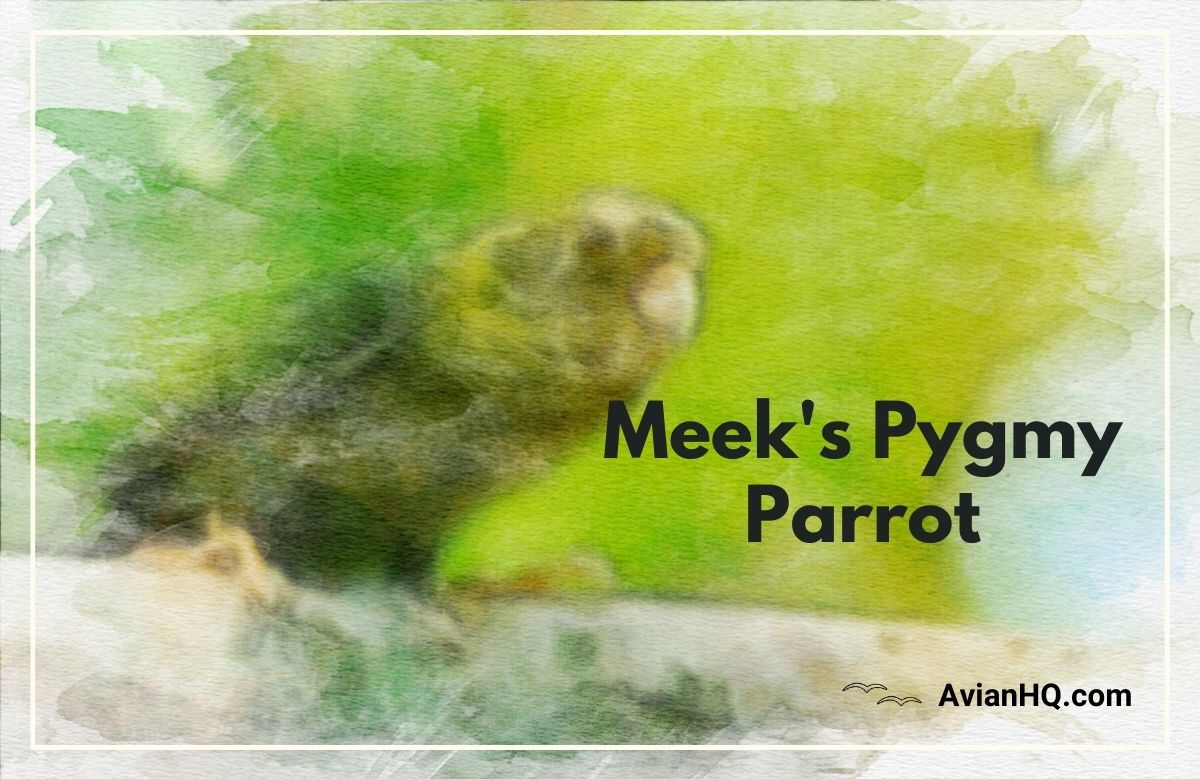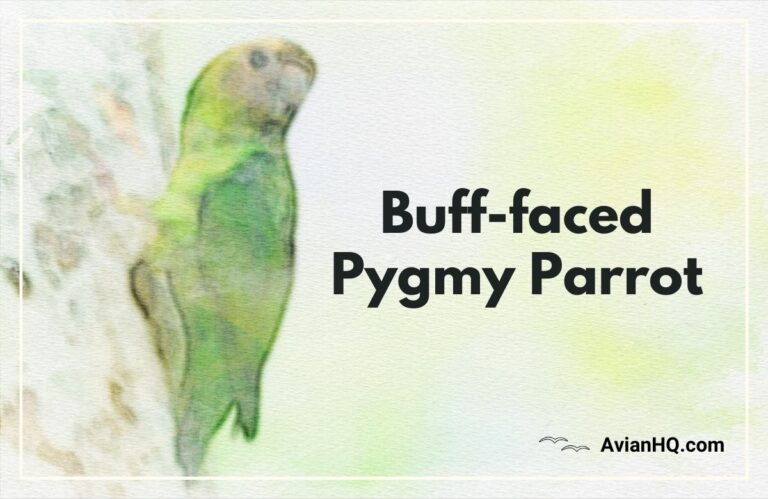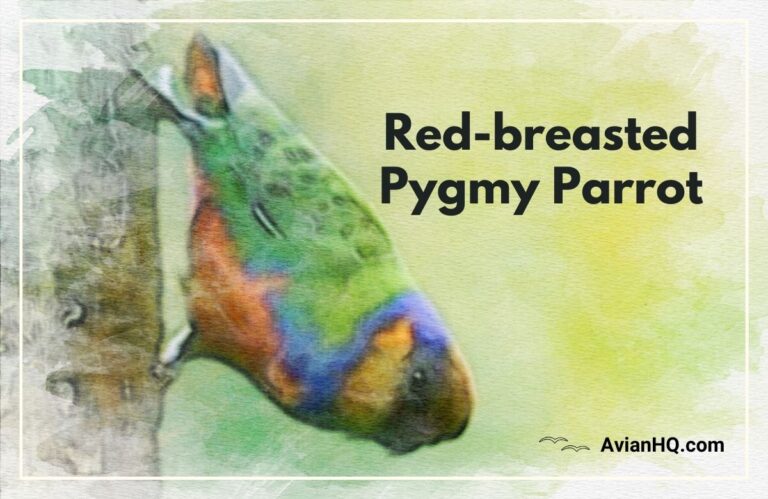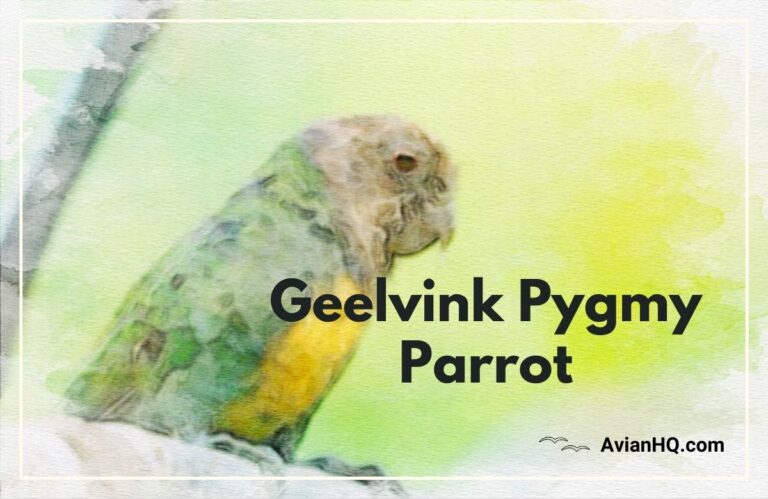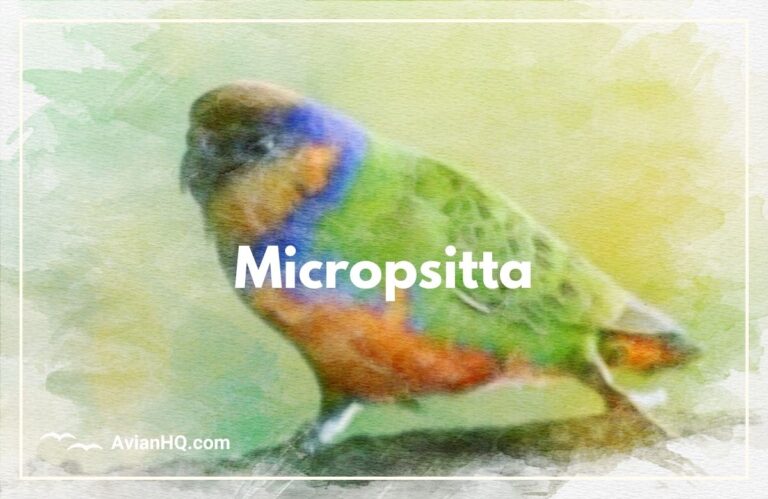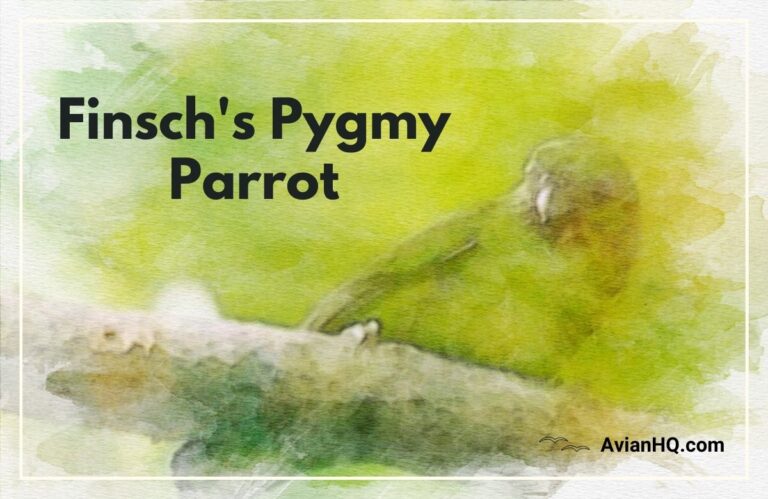Meek’s Pygmy Parrot (Micropsitta meeki)
As you explore the tropical forests of Papua New Guinea, keep an eye out overhead and in the trees for a pop of color zipping by. If you’re lucky, you may spot one of the world’s smallest parrots – the Meek’s Pygmy Parrot.
Measuring just 10 cm long and weighing a mere 42 grams, these tiny parrots pack a lot of color into their petite frames. Their bright plumage flashes emerald green, sunshine yellow, and earthy brown as they scamper among the branches.
While small, Meek’s Pygmy Parrots have big personalities. Get to know these feisty and acrobatic little birds found only in the Admiralty Islands.
History and Taxonomy
The diminutive Meek’s Pygmy Parrot remained unknown to science until the early 20th century. As Western explorers ventured into New Guinea and surrounding islands, they documented many new plants and animals.
Noted English ornithologist Albert Stewart Meek collected the first Meek’s Pygmy Parrot specimens between 1908 and 1913. At this time, New Guinea and nearby islands represented somewhat of a scientific frontier.
Meek surveyed remote regions including the Admirality Islands off New Guinea’s northeast coast. Here he obtained several previously undocumented bird species.
When later describing his finds, German ornithologists Ernst Hartert and Lionel Walter Rothschild named one tiny green parrot Micropsitta meeki in 1914. This honored Meek’s contributions to natural history.
Recognizing Two Unique Island Subspecies
The nominate subspecies, Micropsitta meeki meeki, hails from Manus, Rambutyo, and Lou Islands in the Admiralty group. This represents the original type specimen Meek collected.
In 1924, Rothschild and Hartert documented another isolated population on Mussau and Emirau Islands 185 miles (300 km) to the north. They dubbed these birds M. m. proxima.
The two subspecies have slightly different facial markings and plumage hues. But both share a diminutive stature, with adults averaging just 4 inches (10 cm) long.
Detailed field studies may reveal additional unique island populations. For now, scientists recognize these two subspecies occurring in different island groups.
An Ancient Split to Remote Island Homes
Meek’s Pygmy Parrot belongs to an ancient lineage of tiny parrots inhabiting New Guinea and nearby islands. The genus Micropsitta split from other parrots over 30 million years ago.
At some point, ancestral Meek’s Pygmy Parrots colonized the Admiralty and St. Matthias Islands. Here they evolved in isolation for thousands of years.
Over time, the separated island populations diverged into distinct subspecies. Limited gene flow tends to spur unique adaptations in isolated animal groups.
The ingenious navigator Adelie Bézy first charted the remote Mussau Islands in 1824. But Meek conducted the first biological surveys a century later, revealing many endemic species like M. m. proxima parrots.
Physical Appearance
Though small, Meek’s Pygmy Parrots exhibit brilliant plumage in hues of green, yellow, brown, blue, and black. Their vibrant colors offset diminutive frames averaging just 4 inches (10 cm) from head to tail.
The primary body color is emerald green. The face, throat, breast, and belly shine bright yellow. The crown, nape, and ear coverts feature neat scalloped patterns in brown and grey.
Males and females share similar plumage. Juveniles look like adults, but with slightly duller shades.
The wings and tail display an array of colors. The coverts and secondaries show dark green, while primary flight feathers appear blackish with yellow edging. The short, squared off tail has a greenish-blue center, bordered by blackish-blue and yellow bands.
From below, the wings look dark with yellow undertail coverts. The stout bill and legs are pink, while the eyes are ringed with pink and brown irises.
Subtle Differences Between Subspecies
The two subspecies show subtle variances in their facial and plumage markings. M. m. meeki has faint yellow “eyebrows” and a yellow ear covert patch. M. m. proxima displays a more extensive yellow band above the eyes and a pale brown facial mask.
In both subspecies, the undertail is yellow with a touch of green along the flanks. But in proxima, the yellow hue extends further up the sides of the breast.
Taken together, these distinctions help distinguish the isolated island populations. But considerable overlap still exists between the two subspecies in color and patterning.
Built for Acrobatics
Meek’s Pygmy Parrots have characteristic adaptations for climbing, perching, and rapid maneuvering in the treetops.
Their feet have two toes pointed forward and two back to provide a strong grip. The short, square tail acts as a prop while climbing vertically. Wide wings allow agile flapping flight between trees.
The stout upper bill easily cracks hard seeds, while the sharp lower mandible dexterously picks up food bits. Large eyes offer excellent vision.
Weighing just 0.15 ounces (42 grams), Meek’s Pygmy Parrots are perfectly sized for an acrobatic life in the rainforest canopy. Their efficient anatomy allows them to exploit small openings and to nip through tiny spaces in the foliage.
Habitat and Distribution
Meek’s Pygmy Parrots live exclusively on several islands off the northeast coast of New Guinea. Their total geographic range spans only about 1,200 square miles (3,100 km2).
The birds inhabit tropical rainforests on Manus, Mussau, Rambutyo, Emirau, and Lou Islands. They occur at elevations up to 2,300 feet (700 m) in the forested interiors.
You may also find Meek’s Pygmy Parrots in trees around plantations, gardens, and villages. But pristine, old-growth rainforest provides the most optimal habitat.
The parrots do not inhabit any regions outside their native Admiralty and Saint Matthias Islands. There are no introduced populations elsewhere.
Key Habitat Features
Meek’s Pygmy Parrots rely on specific rainforest conditions and features:
- Abundant lichens, fungi, and insects on tree trunks
- Ample hollows in tall, mature trees for nesting
- Presence of strangler figs and termite nests
- Canopy trees bearing small, hard fruits and seeds
- Vines, epiphytes, and mossy cover for foraging
Selective logging that removes big nest trees can reduce habitat quality. Complete clearing of forest for agriculture leaves the birds nowhere to live.
But the parrots adapt well to disturbed areas, as long as some large trees remain. This flexibility assists the species across it’s limited range.
Shared Home Range with Vulturine Parrots
Across the Admiralty Islands, Meek’s Pygmy Parrots occupy the same habitat as the larger Vulturine Parrot. The two parrots partition resources, with Vulturines eating large fruits and Meek’s specializing on smaller items.
At night, both species may even sleep in the same tree hollows. Up to 30 Meek’s Pygmy Parrots can pack together into prime cavities for safety.
These parrots demonstrate how very different species can coexist in the same niche through resource partitioning. This allows more biodiversity to flourish across the islands.
Diet and Feeding
Meek’s Pygmy Parrots eat a wide variety of foods. Their diverse diet allows them to exploit many small niches across their rainforest home.
Fruit forms a major part of the diet. The parrots favor small, hard fruits produced by laurels, figs, and other canopy trees. Sturdy bills easily crack open even the toughest pericarp.
Nuts and seeds also provide sustenance. Meek’s Pygmy Parrots deftly extract seeds from cones and pods. Their strong jaw muscles grind up hard shells.
To supplement their fruit and seed diet, the parrots feed extensively on insects. They hawk flying insects, probe into crevices, and scrape larvae from leaves.
Additionally, the birds forage for fungi, lichens, and moss covering tree trunks. These provide essential vitamins and minerals.
Foraging Techniques
Meek’s Pygmy Parrots employ an array of foraging techniques to exploit diverse food sources:
- Prying up bark and digging into epiphytes and moss mats searching for insects and larvae
- Climbing along vines and branches, picking off fruits and plucking seeds from cones
- Reaching into crevices in tree bark to extract spiders and other hidden arthropods
- Capturing moths, ants, and other flying insects in mid-air while sallying from perches
- Scraping lichens off of trunks and branches with the ridged edges of their bills
- Descending to the forest floor to pick through fallen fruits and seeds
Social Feeding Flocks
Meek’s Pygmy Parrots feed in small flocks of 6 to 30 individuals. Larger group size provides safety from predators.
Flock members communicate constantly with high-pitched contact calls. Chatter ceases immediately at any sign of danger.
The birds forage actively in a looping, zig-zag pattern. Flocks may travel 500 feet (150 m) or more through the canopy in a single feeding bout.
If separated, Meek’s Pygmy Parrots can identify their flock by distinctive vocalizations. These tight social bonds lend survival value.
Breeding and Reproduction
Meek’s Pygmy Parrots nest in the hollows of tall rainforest trees. They also readily use arboreal termite nests built around living or dead trees.
Nests are typically placed 16-65 feet (5-20 m) above ground. This protects the birds and eggs from most predators.
Both sexes inspect potential nest sites at the start of each breeding season. They choose cavities with small, tight entrances to exclude larger competitors.
Inside, the unlined cavity measures around 8 inches (20 cm) across. Some coarse wood chips may accumulate on the bottom.
Breeding Seasonality
In the wild, Meek’s Pygmy Parrots likely breed year-round. This matches the tropics’ lack of seasonal cycles.
However, food abundance may drive spikes of breeding activity at certain times. For example, peaks could coincide with mast fruiting events that provide ample food.
In captivity, keepers can encourage breeding with extra protein, nesting materials, and extended daylight hours. But breeding success remains low.
Typical Clutch Size
Female Meek’s Pygmy Parrots lay small clutches of just 2 to 3 eggs. Larger broods would tax the available food supply.
The oval eggs measure approximately 0.9 inches x 0.7 inches (22 mm x 17 mm). They are white in color initially but rapidly stain and dull.
Incubation starts after the second egg is laid, ensuring staggered hatching. This gives the first chick a head start.
Roles of Parents
Both parents share incubation duties. However, the female takes the lead role, spending about 75% of her time on the eggs.
During incubation, the male regularly brings food to his mate. He also helps defend the nest site from intruders.
Once hatched, the chicks are fed regurgitated fruit and insects by both parents. Chicks may venture outside the cavity at around 3 weeks old.
Behavior and Ecology
Meek’s Pygmy Parrots spend nearly all their time in trees. Rarely do they descend to the forest floor.
They move actively through the canopy searching for food. Strong legs and feet allow them to cling upside down along branches. The short, stiff tail provides a brace during vertical climbing.
In flight, the parrots exhibit swift, direct wingbeats. Their flight path tends to be straight with rapid turns. This efficient mobility aids their busy foraging routine.
Meek’s Pygmy Parrots constantly pivot their heads to watch for predators while feeding. At any hint of danger, they freeze in place or make a quick dash for a cavity.
Complex Social Behavior
The parrots live in small social groups of 6 to 30 birds outside the breeding season. These flocks likely represent extended family units.
Each flock occupies a home range of around 25 acres (10 ha) in the forest. Ranges may overlap at the edges but core areas remain exclusive.
Flock members communicate with an array of contact calls. Soft chattering indicates calmness during routine activity. Alarm calls signal immediate danger.
At night, communal roosting offers safety from nocturnal predators. Up to 30 birds may cram together into a prime tree hollow.
Usual Lifespan in the Wild
No thorough studies have examined Meek’s Pygmy Parrot longevity and survivorship. But based on related parrot species, their average lifespan in the wild likely ranges from 10 to 15 years.
Disease, predators, accidents, and food scarcity represent the main mortality factors. Only a fraction ever reach their full potential lifespan.
In protected captivity, Meek’s Pygmy Parrots may exceed 20 years. But captive breeding remains challenging due to their specialized dietary and social needs.
Conservation Status
The International Union for Conservation of Nature (IUCN) Red List categorizes Meek’s Pygmy Parrot as a species of Least Concern.
The global population has not been quantitatively assessed. But the birds are described as relatively common across their range.
No evidence points to any substantial ongoing population declines that would warrant a threatened status. The stability owes to several factors:
- Occurs on remote islands with intact forest habitat.
- Adaptable to disturbed areas if large trees remain.
- Wide diet provides resilience against shortages.
- Small home ranges reduce territorial conflicts.
Measured in the Thousands
While no precise surveys have been conducted, rough estimates place the total Meek’s Pygmy Parrot population in the low thousands of individuals.
Across their limited island range of 1,200 square miles (3,100 km2), habitat likely supports 5,000 to 15,000 birds. But this remains an informed guess.
Conducting standardized counts across multiple sites and seasons would help establish an accurate baseline population estimate. This could better inform future monitoring.
Avoiding Major Threats
Fortunately, Meek’s Pygmy Parrots avoid most significant threats facing endangered parrots:
- No trapping pressure due to remote islands
- Intact native forests provide habitat
- Small size limits appeal as pets
- Endemic range prevents introduced predators
Continued protection of Admiralty and St. Matthias Islands will ensure suitable forest habitat persists. This offers the best safeguard for maintaining healthy Meek’s Pygmy Parrot numbers into the future.
Cultural Significance
While diminutive in size, Meek’s Pygmy Parrots play an integral role in their island forest ecosystems.
As canopy frugivores, they disperse the seeds of many rainforest plants. Their small size allows them to reach fruits missed by larger birds and bats. This assists regeneration of the vegetation communities.
Meek’s Pygmy Parrots also contribute to pest control. Their insect-rich diet helps regulate invertebrate populations that could damage trees.
Through these key ecological roles, the parrots help maintain the diverse plants and animals sharing their tropical forest homes. Their loss would leave an empty niche.
Potential for Ecotourism
The parrots’ bright colors, acrobatic nature, and tiny size give them appeal for ecotourism.
As Admiralty and St. Matthias Islands develop limited nature-based tourism, Meek’s Pygmy Parrots could serve as an attractive highlight.
Intrepid birders already seek out the species during forest tours. With sufficient habitat protections, controlled tourism revenues could aid local villages.
But any commercial activities around the parrots need careful management. Heavy disturbance could negatively impact their breeding and feeding behaviors.
Promoting Forest Conservation
Meek’s Pygmy Parrots could become a prominent flagship species for preserving Admiralty Island forests.
High profile species like parrots better connect people to conservation values. They provide a relatable face to environmental campaigns.
With it’s restricted range and colorful persona, Meek’s Pygmy Parrot makes an ideal candidate. But first, local communities must embrace the parrots as worth protecting.
Conclusion
The emerald green Meek’s Pygmy Parrot ranks among the world’s most diminutive parrots. What it lacks in size, it makes up for in acrobatic skill and vibrant plumage.
When traversing the rainforests of Admiralty New Guinea, keep an eye out overhead for a flash of color. With luck, you may spot one of these feisty pygmy parrots foraging for fruit.
Take a moment to appreciate the wonder of such a minute and well-adapted bird. At just 4 inches long, Meek’s Pygmy Parrot has thrived for millennia in it’s remote island homes.
Yet despite it’s resilience, this tropical canopy jewel requires diligent habitat protection. Preserving stands of mature, nesting trees remains key to safeguarding it’s future.
Through responsible stewardship of Admiralty Islands’ forests, we can ensure Meek’s Pygmy Parrots continue to brighten their endemic range for centuries to come.

